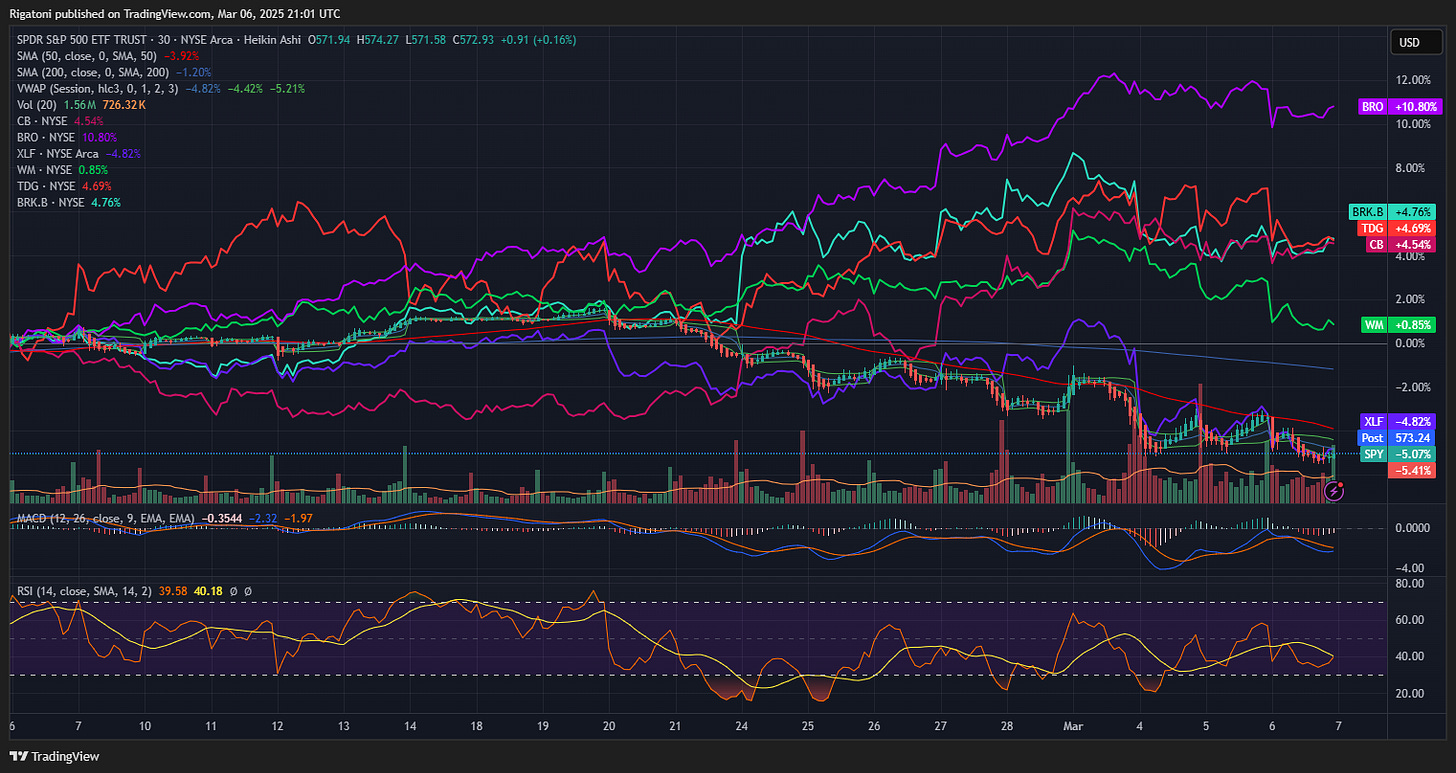The Real World vs. Wall Street
The general public is just beginning to grasp the potential disruptions that new tariffs could bring to their daily lives. However, unless someone relies heavily on imports from Canada or Mexico, these tariffs likely won’t have a significant direct impact on their routine. At this point, I see this as more of an availability issue rather than a clear driver of higher prices (at this time).
Domestic customers have multiple options when responding to the new duties—cancel shipments, absorb the 25% tariff, or negotiate a tariff split. This means every transaction will play out differently, making broad predictions about inflation or economic damage difficult.
Stock Market Volatility and the Psychology of Uncertainty
When investors feel uncertain about the macroeconomic environment, it shows up in stock prices, regardless of whether tariffs directly impact the top holdings of the Nasdaq 100. At some point, if no further trade disruptions emerge, the market will likely rebound simply due to the relief of certainty—even if there’s an earnings hit in the short term.
If we see a broader slowdown in consumer spending and growing economic uncertainty beyond tariffs, then we might not get the quick “V-shaped” bounce everyone is hoping for. Instead, a deeper drawdown could unfold. That’s why betting on short-term market moves is just that—gambling.
Right now, the media is pushing the narrative of market chaos, but let’s be real—we haven’t even gotten a CNBC “Markets in Turmoil” special yet. That tells me things aren’t that bad…yet.
The S&P 500 still has some ground to cover before it reaches a full 10% correction, and while the Nasdaq 100 has come close, it technically hasn’t quite hit that 10% level either. If nothing else, that tells me there’s still room for further downside before the media goes full panic mode.
It’s my opinion that we felt that full panic mode during August 5th, 2024 around the Japan Carry-Trade sell-off.
Buying the Dip? The QQQ Almost Hit My Target
I’ve said before that I want to see the QQQ correct by 10%, which would put it around $485. Today, we got extremely close, bottoming at $487 before bouncing.
Would buying today’s dip be a mistake? Probably not in the long run. The VIX has been gaining momentum but hasn’t convincingly broken through resistance around 26 points, so this isn’t screaming a full-blown panic just yet.
The U.S. Dollar, Yield Curves, and What Matters Most
A lot of traders are obsessing over the U.S. Dollar Index as the ultimate market indicator. I don’t necessarily disagree—it does tell us a lot about macro trends. But let’s not forget that stocks can still do well in a weakening dollar environment.
Meanwhile, bond traders continue watching the yield curve, particularly for inversion signals. Personally, I don’t rely on yield curves as a long-term investor, but the 6-month and 2-year yields remain inverted, which suggests one of two things:
Stagflation concerns—the market pricing in slower economic growth with sticky inflation.
Higher odds of Fed rate cuts in the next 12 months—if the Fed pivots, this would likely steepen the yield curve and ease recession concerns.
At the moment, the 2-year yield (3.961%) is still below the 10-year (4.287%), so we aren’t seeing a renewed inversion between these two key benchmarks. That tells me the recession alarms aren’t blaring just yet (if you’re convinced this is a good indicator).
Growth Stocks Are Getting Destroyed (and That’s Healthy)
Some of these hyper-growth momentum names are getting absolutely obliterated—and I think that’s a good thing.
AppLovin (APP), Palantir (PLTR), Dutch Bros (BROS)—all getting wrecked.
CAVA looks rough, but honestly, it needed to go through a valuation correction before climbing higher again.
Spotify (SPOT) isn’t selling off as much as I’d like, which probably confirms how strong the business is.
Hims & Hers (HIMS) is getting completely destroyed—probably due to more Nordo news, which is scaring off short-term investors/traders. This one is a retail-heavy name that likely needs to correct further.
One stock I’ve started watching: Blue Owl Capital (OWL). I want to learn more about their business, but the way private capital names are being treated right now, you’d think we were already in a deep recession.
Amazon Below $200? Tempting, But I Want More Pain
Many investors get seduced when Amazon trades below a round number like $200 per share. We briefly hit $199 today, and yes, I do think this is probably a good time to buy.
That said, I still want to see more pain in QQQ before I pull the trigger. If the Nasdaq 100 takes another leg down, Amazon will likely get dragged even lower, offering an even better entry point.
Chipotle (CMG) Heading Lower—But I Want It Much Lower
Chipotle is now testing its August 5th lows, which makes sense to me. But I still want to see more downside before I’d consider it attractive.
Ideally, below $50 per share would be my buy zone.
Recession-Resistant Stocks Are Holding Up Well
While tech names are taking a beating, more recession-resistant names are barely down or even holding steady. These are just a few I watch closely on a daily basis:
TransDigm (TDG)
Waste Management (WM)
Chubb (CB)
Financials (XLF)
Brown & Brown Insurance (BRO)
These stocks aren’t getting smacked nearly as hard as tech, which is typical when the market starts pricing in potential economic weakness.
Final Thoughts: Stay Patient, Let the Market Come to You
If you’re a long-term investor, none of this volatility should be making you panic. I still believe the best approach is to sit on your hands and wait for attractive valuations. We are getting close, very close.
Thanks and have a great night!
In case you missed it:
Disclaimer: This blog is for informational purposes only and does not constitute financial advice. All opinions are my own, and I am not a financial advisor. The information provided reflects my personal views and is intended to encourage discussion and thought among readers. Investments involve risk, including the loss of principal, and past performance is not indicative of future results. Always conduct your own research or consult with a qualified professional before making any financial decisions.









